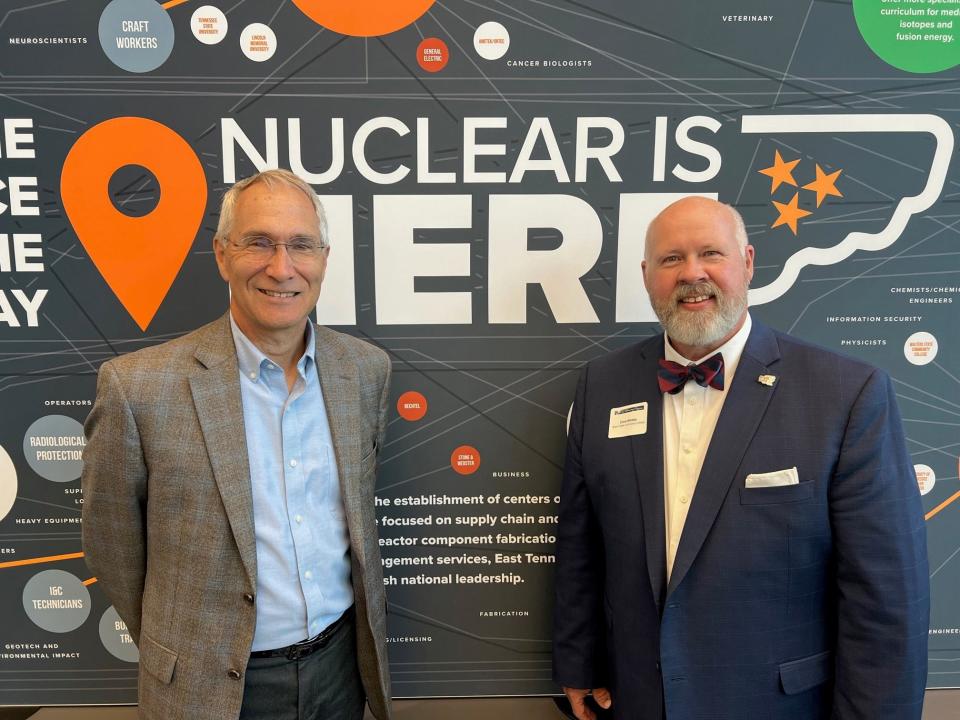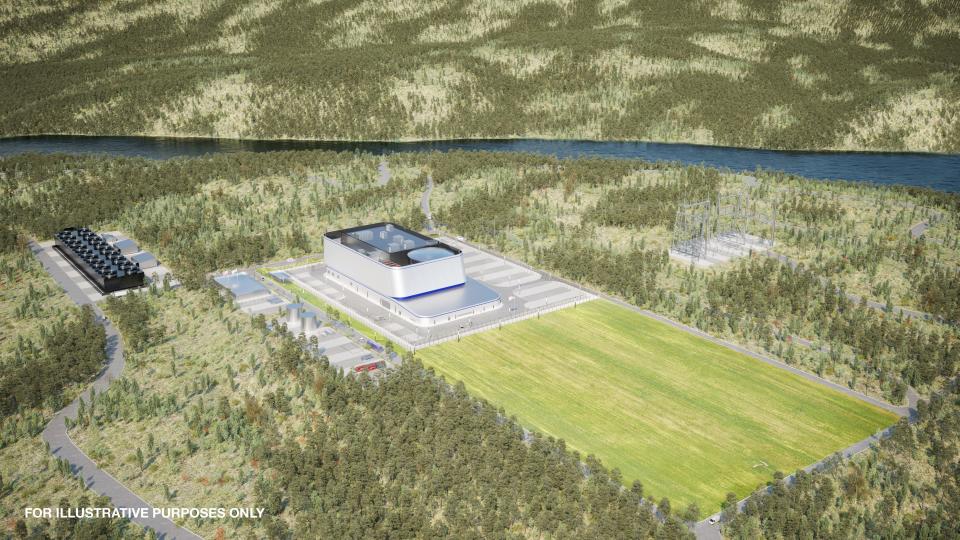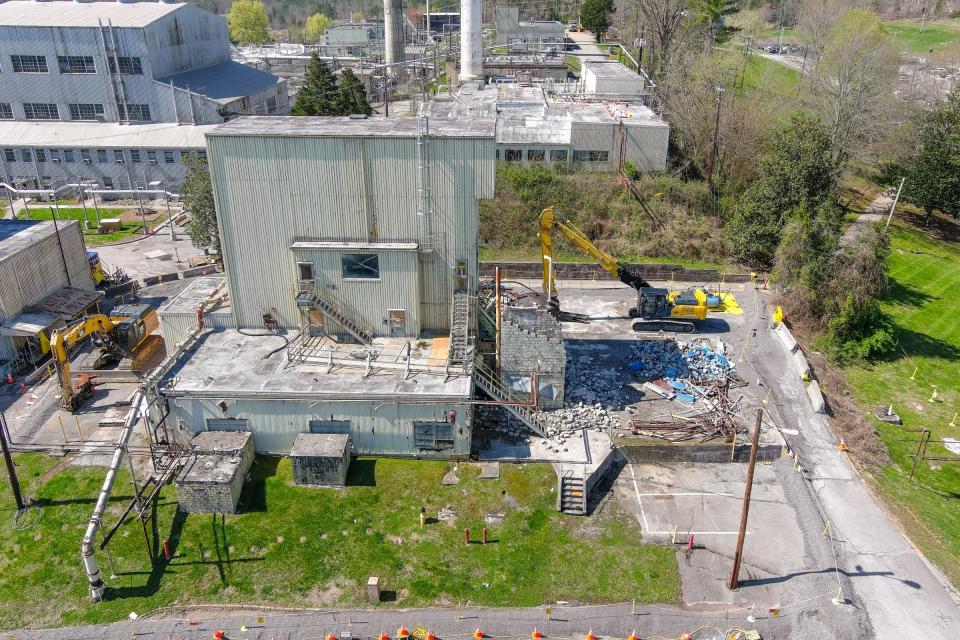'Nuclear is here': Why a nuclear renaissance is happening in Knoxville and Oak Ridge
In the world of nuclear energy, no name is so storied as Oak Ridge, particularly to the companies and partners now making the city a center of what many have called a coming "nuclear renaissance."
Now, in the literal footprint and the proverbial shadow of the Manhattan Project, new nuclear companies hoping to accelerate the national transition to clean energy are coming to Oak Ridge and nearby Knoxville.
Created in 1942 as the first production site of the Manhattan Project, Oak Ridge was the birthplace of the world's first continuously operating nuclear reactor and the Nuclear Navy, whose reactors are still fueled by Y-12 National Security Complex. Oak Ridge National Laboratory has built and operated 13 nuclear reactors that powered discoveries across its 80-year history, and one still operates today.
The phrase "nuclear renaissance" suggests a rebirth, and nuclear energy could be headed for a comeback as worries about carbon emissions and a dying coal sector spur historic federal investments in clean energy and the nation's electric grid faces mounting pressures from electric cars and artificial intelligence.
Nuclear has been feared and rejected in many quarters owing to disasters like those at Chernobyl in 1986 or Fukushima in 2011, which led several nations, most notably Germany, to phase out their nuclear power plants. Still, nuclear remains one of the safest and cleanest sources of power.
The United States is accelerating its move to nuclear as President Biden makes new nuclear power generation a key to his goal of a carbon-free U.S. power grid by 2035 and a net-zero emissions economy by 2050. Most Americans, about 57%, support building more nuclear power plants to generate electricity, up from just 43% in 2020, according to Pew Research Center.
The U.S. is in a position to triple its nuclear energy output by 2050, from 100 gigawatts to 300 gigawatts, enough to power more than 200 million homes, according to a report from the Department of Energy in March. The growth would be driven by advanced nuclear technology such as small modular reactors so long as they are proven to be affordable enough to attract utility companies and private investors.
Work on advanced nuclear technology is accelerating in Knoxville and Oak Ridge, where partners like ORNL and the Tennessee Valley Authority are attracting private nuclear companies.
“We as a country sort of stepped away from nuclear for a period of time and so when people talk about the nuclear renaissance, I think they're referring to the hope that nuclear power generation will once again become an asset that more utilities are prepared to invest in,” Jeff Smith, retired interim director and chief operations officer at ORNL, told Knox News.
Smith sits on the Tennessee Nuclear Energy Advisory Council, created by Gov. Bill Lee in May alongside a $50 million nuclear fund to make the state a national name in the clean energy transition.
Lee didn't make the announcement just anywhere or with any crowd. He signed the executive order at the Zeanah Engineering Complex, the sleek home of the University of Tennessee at Knoxville's highly ranked nuclear engineering department, surrounded by Knoxville Mayor Indya Kincannon, UT System President Randy Boyd and TVA chief operating officer Don Moul.
The small ceremony was a clear signal that Tennessee's road to the nuclear renaissance runs through Knoxville and Oak Ridge, which together are home to more than two-thirds of all nuclear companies in the state.

Dozens of nuclear partners in East Tennessee
A tight cluster of national nuclear leaders sets the Knoxville region apart. Within a 50-mile radius of UT sit about 150 nuclear companies, and the UT campus is only 30 miles from ORNL, the largest science and technology national lab. The frequent collaborators are powered by TVA, which leans on its nuclear fleet for 42% of its electricity generation. The region's mission is further diversified by Y-12's national security focus.
"East Tennessee is poised to be the Florence of the 'nuclear Renaissance.’ The time is now. The place is here," Tracy Boatner, president of the East Tennessee Economic Council, told Knox News. "Combine these assets with a pro-nuclear community and state that is investing significantly in attracting nuclear industry and you have the optimum environment for growth and innovation."
At its annual nuclear conference in August, the council unveiled a 20-foot-long visual aid that maps out critical nuclear organizations and workforce needs in a complex web across Tennessee. The title of the graphic, "Nuclear is Here," suggests that a new kind of nuclear energy has arrived and is welcome in the Volunteer State.
Boatner led a Knoxville application for the Regional Technology and Innovation Hubs program, called Tech Hubs, a federal initiative through the U.S. Economic Development Administration to spur domestic research and manufacturing.
With 40 partners, the East Tennessee Economic Council made the case that Knoxville and Oak Ridge will be a national center for nuclear science worthy of special treatment and funding. The application was unsuccessful.
Nearly 200 cities and regions across the country applied to become tech hubs and only 31 were selected in a "merit-based review," a spokesperson for the Economic Development Administration told Knox News.
Tech hub designees needed to demonstrate their impact on the entire U.S. and not just their region. They also needed to show they had a ready workforce, were committed to equity and diversity and had innovative "lab-to-market" approaches, like the partnership between ORNL and TRISO-X, a division of X-energy working to commercialize a new kind of nuclear fuel developed at the lab.
The Economic Development Administration has not provided feedback on the application. Still, the partnerships and goal-setting required for the three-month process were another step towards the nuclear renaissance, Boatner said.
A spokesperson for the Biden administration told Knox News it would host a webinar for hubs that did not receive the designation.
Oak Ridge history makes it friendly to nuclear
When the Oak Ridge Office of Environmental Management finished demolition and cleanup of the historic K-25 site, a massive Manhattan Project facility that used gaseous diffusion to enrich uranium, it freed up 2,200 acres for private companies like Kairos Power and Ultra Safe Nuclear to develop next-generation nuclear technology.
Two industrial parks in Oak Ridge, the Heritage Center and the Horizon Center, have becomes cradles for advanced nuclear technologies, said Christine Michaels, president and CEO of the Oak Ridge Chamber of Commerce.
The city's population, which nearly doubles each day when 31,000 workers commute to work, is familiar with nuclear technology. At public hearings on Kairos Power and TRISO-X's intent to build facilities in Oak Ridge, not one person spoke out against the projects, Michaels said.
“Who wants to really go into a hostile environment with their project?” Michaels said. “You want to be somewhere where there's cooperative sentiment, and where you have a workforce that is being developed that understands your technology and wants to work with you.”
The executive team from California-based Kairos Power visited Oak Ridge on Dec. 5 for the opening of a new exhibit at the American Museum of Science and Energy, which tells the story of molten salt reactor technology from its early development at ORNL through its pending commercialization at Kairos.
A years-long partnership with the lab has been central to Kairos's mission to bring an affordable salt-cooled high-temperature reactor to market, CEO Mike Laufer told Knox News. Building its demonstration reactor, Hermes, in Oak Ridge is a continuation of the legacy.
“There’s a strong talent pool here that’s very familiar with nuclear technology,” Laufer said. “The southeast, and quite possibly East Tennessee, is likely to be the growth point, the starting point, for the next round of new nuclear that we would hope to build in this country.”
Laufer cautioned that the nuclear renaissance is an aspiration and not yet a reality. The nuclear industry has been marked by 60 years of research on advanced technologies subject to a start-stop shuffle towards commercialization.
“Having humility about the challenge ahead of us will serve us well, because there have been false starts of nuclear hopes in the past that haven’t proved a reality,” Laufer said. “If nuclear is going to play a significant role in decarbonization, we need those technologies ready now and we need to get ready to scale them up in the 2030s.”
In October, the Nuclear Regulatory Commission held a hearing on Kairos's construction application for the Hermes reactor. Laufer said the hearing went well, thanks in part to a letter of support from Oak Ridge officials. The company expects to start construction on Hermes in 2024.

Affordability is key to East Tennessee's nuclear renaissance
More than just demonstrations of technology, Hermes and TVA's small modular reactor under development at the Clinch River Nuclear Site demonstrate new kinds of nuclear reactors can be built on schedule and on budget, a major hurdle in the expansion of nuclear energy.
There are 93 nuclear reactors generating electricity at 54 power plants across 28 states, according to the U.S. Energy Information Administration. The average age of a reactor is 42 years old.
In the 21st century, only two new reactors have become operational in the U.S., Unit 2 at TVA's Watts Bar Plant in 2016 and Unit 3 at Georgia Power Company's Plant Vogtle earlier this year.
The new reactor at Vogtle, which came online seven years late and $17 billion over budget, has become a byword for nuclear's spotty record on affordability.
“We need to demonstrate that nuclear can be done cost effectively and that, to me, is the primary challenge before we'll be able to look back 20 years from now and say that the nuclear renaissance did indeed happen," Jeff Smith, the former interim director of ORNL, told Knox News.
If TVA successfully completes its small modular reactor, the first to get early site approval from the Nuclear Regulatory Commission, it plans to build more at the Clinch River Site. That won't happen until the 2030s, but it could provide a model that would rapidly expand nuclear generation across the country and the world.
“This isn’t just to build another nuclear reactor in East Tennessee, like Watts Bar," said Mickey Wade, associate laboratory director for the fusion and fission energy and science directorate at ORNL. "It’s to provide the fuel, the materials, the designs for nuclear reactors around the world and that’s a significant opportunity."

University of Tennessee leads training of next-gen nuclear leaders
When nuclear companies decide to locate in Knoxville or Oak Ridge, they want to know that a steady and skilled local workforce can meet their needs. That's where the oldest nuclear engineering department in the country comes in.
Established in 1957, UT's department of nuclear engineering is consistently ranked in the top 10 nationwide and is growing as a majority of its students come from out of state, said Wes Hines, department head.
The department is in a unique position because of its proximity to ORNL and TVA, as well as about 150 nuclear companies interested in hiring its graduates. But its undergraduate and graduate students can't supply all the workforce needs of the rapidly growing sector. ORNL is partnering with Pellissippi State Community College and Roane State Community College to meet nuclear workforce needs.
“You couldn't set yourself up in a better way than to be next to all these industrial and government partners,” Hines said. “At some point, we have to get rid of fossil fuels. It's going to have to be done through a combination of renewables and clean energy sources such as nuclear and we're going to have to move towards nuclear."
Electricity demand in the U.S. could double by 2050, the same year that the Biden administration wants a net-zero carbon emissions economy. TVA has adopted the same goal for its own system, and has worked to attract nuclear companies to the Knoxville region to maximize reliable carbon-free power generation.
Speaking at the opening of the Kairos exhibit at the American Museum of Science and Energy, TVA President and CEO Jeff Lyash said the U.S. must have a strong clean energy infrastructure in order to compete with other world superpowers in the coming decades.
Competitiveness in the domestic clean energy market, born largely out of pioneering research and development at ORNL and Y-12, begins at home for TVA.
“In the end, I think this is where it all starts," Lyash said to a room of Oak Ridge leaders and residents. "This is where it’s all going to happen."
Correction: An earlier version of this story misstated ORNL's relative size. It is the largest of the DOE's multi-program science and technology labs.
Daniel Dassow is a growth and development reporter focused on technology and energy. Phone 423-637-0878. Email daniel.dassow@knoxnews.com.
Support strong local journalism by subscribing at knoxnews.com/subscribe.

This article originally appeared on Knoxville News Sentinel: 'Nuclear is Here': Knoxville, Oak Ridge emerge as nuclear leaders
